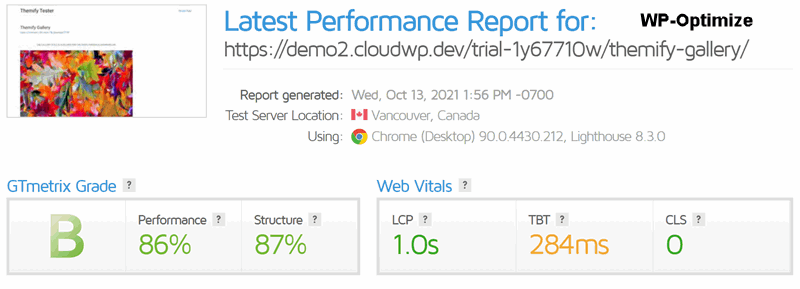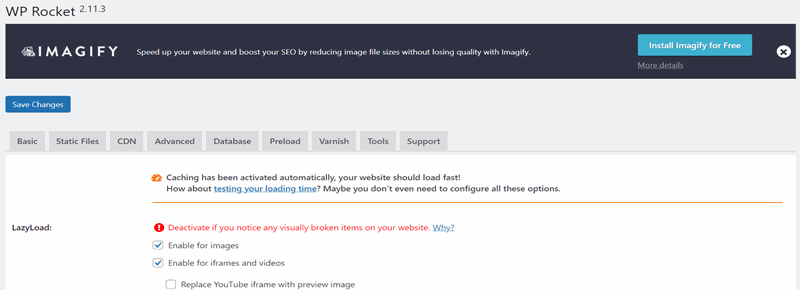Within the last two years there has been a whole new batch of better WordPress Performance Optimization plugins. What sets these plugins apart from the many caching and image compression plugins is that many of the new Gun Performance plugins incorporate not just caching tools but also image compression, database optimization, app assets cleanup, and HTML/CSS/JavaScript minification/combination all under one tool. So the question arises how effective are these new Gun Performance Tuning plugins. So here are some performance tuning results based on tests of the same Themify Builder landing page design.
The New Gun Performance Tuning Tools
Some of these are old familiar caching apps with added tuning features. Others have branched out of database optimization and added broader tuning capbilities. Here is a list of the new Performance Tuning tools – can they deliver top results?
- Here is the Themify Landing Page used in all the tuning tests
- WP-Optimize has a 5 star WP rating from 1500 users and 100K active clients for a free + pro at $50US/yr/site
- Clearfy has a 4.4 star WP rating from 287 users and 100K active clients for a free + pro at $50US/yr/site.
- LiteSpeed has a 5 star WP rating from 1,738 users and 2 million active clients It is free.
- W3Total Cache has a 4.5 star WP rating from 5,003 users and 1 million active clients It is free
- Hummingbird has a 5 star WP rating from 1,208 users and 100K active clients It is free.+ pro at $60US/year/site
- WPRocket has no free version and costs$49US/year/website
- Combo of 3 performance tuning plugins – WP Fastest Cache with 3,477 5 star ratings and 1 million active clients plus Autoptimize with 1282 4.3 star ratings and 1 million active clients plus
Themify Builder Landing Page used in all the tuning tests:
This Landing Page for a travel site has a gallery, slider, and portfolio of posts. So it stress tests image loading and complex JavaScripts usage. Here is the base line test results with no optimizations turned on: The only good news is that CLS value is very good at zero shift. But hidden from view is the 7 seccond Fully Load time. So clearly the landing page can use some performance tuning work.
The only good news is that CLS value is very good at zero shift. But hidden from view is the 7 seccond Fully Load time. So clearly the landing page can use some performance tuning work.
If you read the WordPress Performance tuning reports, a consensus is forming around the basic processes:
- Web HostingServices are getting better but improvements in hosting can be reflected in 10% to 70% better response time.;
- Next compressing images and separately videos with lossy but still quality media renderings can often deliver 20% to 50% better response time;
- Caching plugins are also vital in delivering performance improvements. Many caching plugins add HTML/CSS/JavaScript minifications and combination settings including defering and lazy loading features. There are many good choices as seen below.;
- Database Optimizing plugins reduce the size of the intial database load . But again, many database plugins offer caching and minification services;;
- Conditional Component Usage plugins are the latest step in page/post speed optimiation. Again, depending on plugins these tools can deliver;
- Finally there is a whole array of mobile specific optimizations really shaking up WordPress delivery.on small screens.
WP-Optimize is a prime example of the trend to multii-tool Backend plugins. Look at the array of tools that the plugin provides for more than performance tuning: Database Optimization, Inage Compression, Caching Settings, Minification of HTML/CSS/JavaScript, The caching tools are first rate providing preloading, gzip compression, and a purge cache button.. Ditto for the database optimization as it has a dozen data cleanups beyond the table optimizations and deletion of unused tables.

The dashboard is easy to use and provides helpful tooltip hints for most of the settings.
 Missing from this tuning run is no image lazy loading, no purge of unused images and most important no unused asset clean-up.
Missing from this tuning run is no image lazy loading, no purge of unused images and most important no unused asset clean-up.
Clearfy is an even more loaded multi-tool backend plugin. It supports caching options, SEO settings, basic database cleanup, minification /deferring/aggregation of HTML/CSS/JavaScript code, Admin panel/menubar/notfication settings, cybersecurity options CDN integration and asset cleanup options. However, we encountered two fundamental problems with Clearfy. First after setting some of the Clearfy settings we could not re-enter the Settings Dashboard or the special Clearfy Startup page. Not Good. The second problem is figuring out what is actually available free from Clearfy[checkout the website]. .

The fact that I could not connect back to either the Settings Dashboard nor to the Setup Wizard is a fundamental problem to be fixed,
 Lazy loading and image compression are the two missing tuning features.
Lazy loading and image compression are the two missing tuning features.
LiteSpeed Cache is devoted to Performance Tuning with Cache options, CDN integrations, HTML/CSS/JavaScript minification, combining and deferring plus GZIP compression. There is also object memcaching, image optimization with lazy loading. LiteSpeed supports WordPress Multisite and is compatible with most popular plugins, including WooCommerce, bbPress, and Yoast SEO. But there is a blocking requirement, the plugin only works with LiteSpeed Server or Quic.Cloud CDN server.
 LiteSpeed Cache has an easy to use point and click settings dashboard.
LiteSpeed Cache has an easy to use point and click settings dashboard.

This is similar to the SiteGround Optimizer which only works with websites using SiteGround Web Hosting Services.
 W3 Total Cache has a suprb Setup Guide which rescues the confusing setup dashboard and overfilled menubar subcommands. And the number of upgrade nags is atrocious. Fortunately basic plugin delivers good performance
W3 Total Cache has a suprb Setup Guide which rescues the confusing setup dashboard and overfilled menubar subcommands. And the number of upgrade nags is atrocious. Fortunately basic plugin delivers good performance

Even without image compression or asset cleanup, W3 Total Cache delivers a solid performance improvement with onload time at 1.3 sec and fully loaded 3.3second.
 Hummingbird has a point and click dashboard for all the key settings with tooltip hints for some options. But switching between dashboard pages was 4-8 seconds slow.
Hummingbird has a point and click dashboard for all the key settings with tooltip hints for some options. But switching between dashboard pages was 4-8 seconds slow.

Hummingbird delivers one of the fastest tuning tests of 1.2 sec TTI Time To Interactive. All this without using the integrated CDN nor any asset cleanup tool.
 WpRocket, follows the point and click approached used by amost all of the Performance tools, but switching between dashboard pages was 4-8 seconds slow.
WpRocket, follows the point and click approached used by amost all of the Performance tools, but switching between dashboard pages was 4-8 seconds slow.
 WPRocket posts median LCP time but good TBT and very fast Time To Interfactive and Full load
WPRocket posts median LCP time but good TBT and very fast Time To Interfactive and Full load
Combo Test combines 3 Performance plugins that fill in each others shortcomings – WPFastest Cache with a 5 WP rating from 3577 users on 1 million active sites, Autoptimize with a 4.4 WP rating from 1282 users on 1 million active sites, and WP Performance Score Booster with a 4.4 WP rating from 313 user on 30K sites.. This combo was used on another client site about a year ago to good effect.
 WP Fastest Cache has patched a XSS fault with its upated 0.95 version. The plugin has links to missing image compression and CDN services [low/no cost options] .
WP Fastest Cache has patched a XSS fault with its upated 0.95 version. The plugin has links to missing image compression and CDN services [low/no cost options] .
 Autoptimize setup uses a point and click accordion with links to caching, CDN, and other tuning tools
Autoptimize setup uses a point and click accordion with links to caching, CDN, and other tuning tools
 WP Performance Score Booster has a simple setup with offers for added tuning options. But the options for GZIP compression, browser caching and page preloading are just the Booster shots required.
WP Performance Score Booster has a simple setup with offers for added tuning options. But the options for GZIP compression, browser caching and page preloading are just the Booster shots required.
 Combo plugins runtime was a bit slow with good TBT and very fast Time To Interfactive but the Full Load Time at 3.3sec was median
Combo plugins runtime was a bit slow with good TBT and very fast Time To Interfactive but the Full Load Time at 3.3sec was median
Conclusion
From the outset there are 3 factors that have effected the Performance testing:
- For testing a Boldgrid Cloud Instance [17th of 40] was used and the shared hosting delays of 500 to 700msec were apparent in all the Waterfall reports;
- Given that images were 90% of the page load and 32% of page requests they played a major role in the testing. The WP-Optimize Smush compressioons were locked in for all of the tests. This means all of the image compression settings were uniform for all the tests. Yes, this means superior image compression capabilities were missed[ for example, use of WebP or AVIF file formats of some ttuning options ]. However, each tool’s lazy loading of images were part of the tests;
- Two Optimization factors, CDN-Content Delivery Network options and Asset Cleanup routines were barely tested.
